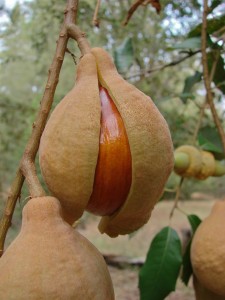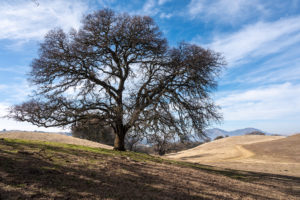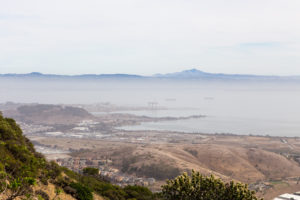“Well, hello there!”
The greeting popped out of my mouth one April morning as I stopped to admire the budding clusters of California buckeye flowers spearing skyward from the rounded crown of a tree.
The new blossoms are familiar and vivacious in the springtime, like transient friends who appear suddenly, orate tales of their latest adventures, and breeze off as quickly as they came.

By early July, however, the pink flowers are flaking off and the trees, also known as “horse chestnuts,” are readying their fruit. Now’s the time to experience their transition into summer dormancy, and their oddball appearance amongst all the fully-foliaged neighbors.
Within the next few months you’ll probably notice many pear-shaped pods dangling from the branches, splitting open to reveal large, dark brown seeds. And if you stop to think a moment, you might wonder — huh, now why is that tree leafless in summer?
Fear not, there’s life in it yet!
Aesculus californica, the only buckeye native to California, is the first to get its leaves and the first to lose them every year. Unlike the many trees that go limp around here without watering, it’s a true Californian who knows how precious water can be in this Mediterranean climate. Shedding leaves helps minimize evaporation, an adaptation that conserves water during the dry summer season.
Toxic to some
The genus name aesculus (pronounced ESS-kew-lus) has Latin roots and essentially means “oak with edible acorn.” Ironically, all parts of the tree contain aesculin and saponin, chemicals that have unpleasant effects if ingested. Humans might experience vomiting, diarrhea, and in rare cases temporary paralysis or even death if any parts of the tree are ingested raw.

The California ground squirrel is known to eat the raw seeds without much ill effect, and native pollinators like bees and butterflies can feed on the flowers without meeting an early demise. It’s a different story for non-natives.
“Buckeyed bees” are what apiarists call honey bees affected by the toxin, and there can be severe consequences for hives. The larvae will be killed within a few days of eating saponin-laced honey or they’ll emerge from their cocoons severely deformed. Adult bees will have paralysis-like symptoms, and the queen’s egg production will decrease significantly or stop altogether.
Despite the toxicity, Native Americans were known to use buckeyes as a food source when harvests for other, more palatable (and presumably less labor-intensive) plants were low. By pounding the seeds into powder and soaking the meal for days to leach out the poisons, they could eventually cook and eat the flour.
The toxicity worked in their favor, as many tribes used a technique of tossing handfuls of raw seed powder into slow-moving pools to stun fish, making them easier to catch. Some would use the bark as a poultice for snake bites, and yet others would use pieces of the seed as a suppository to relieve hemorrhoids — but that’s a tale for another day.
Summer hibernation
The next time you pass a buckeye, take a moment to look for the last hurrah of their spring flowers, creeping brown crispness on the leaves, pear-shaped pods drooping from the branches, or seeds on the

ground that call out to be picked up and admired.
And when you finally see them bare in silver-barked glory as you sweat off your sunscreen and really understand what this “minimizing evaporation” adaptation is all about, remember to wish a happy slumber to these familiar icons of the Bay Area.
Constance Taylor is a Bay Nature editorial intern and founder of Wild Oakland. This piece on California buckeyes is part of “Wild in the City,” a new Bay Nature series exploring the nature that surrounds our everyday living spaces.





